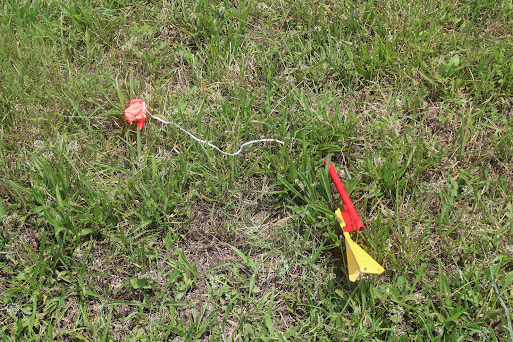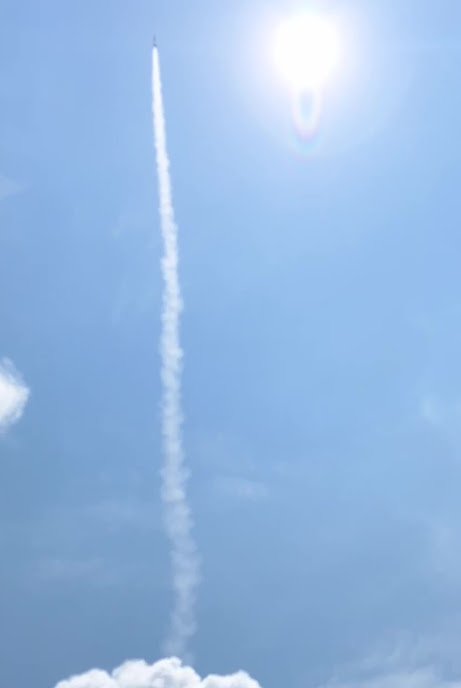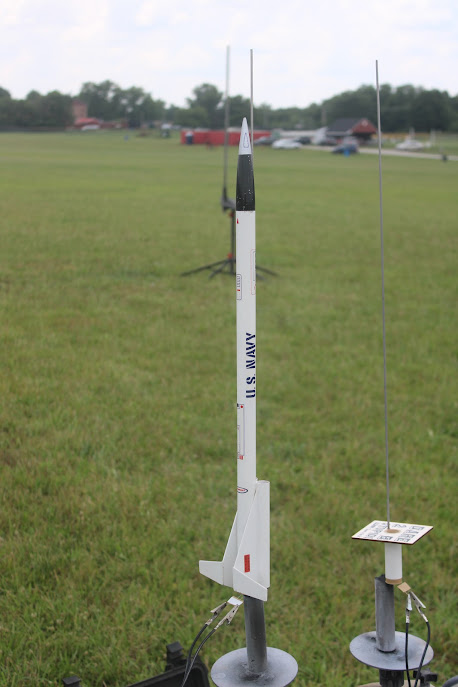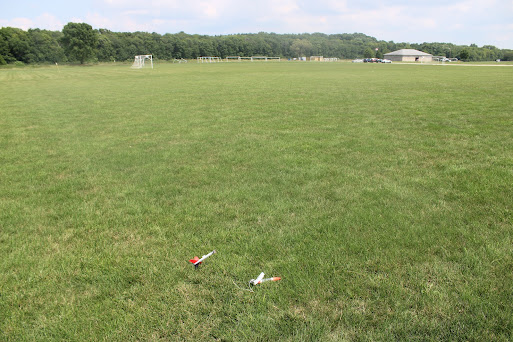I knew things were going to be uncomfortable for the Wright Stuff Rocketeers launch at eRockets Field on Saturday, July 13, so I went sleeveless. This is a brilliant work-around for spending the day weighed down by sweaty sleeves. You aren't as weighed down because rivers of sweat course down your arms from shoulders to fingertips all day. Everything you touch winds up sodden. Then again, Coppertone is one of my favorite smells from childhood, so there's a bright side to all of this, at least until the Coppertone washes away after the first fifteen minutes.
Did I mention the heat?
My day had an interesting start almost from the time I hit the road. Several years back I collected the Mylar adhesive covers from an envelope at work, thinking that they would make good streamers for small rockets and just add a layer of visibility to any rocket that got high enough to need it. I found the envelope on Friday while I was prepping and stuck it in the box'o'rockets. 20 minutes into the trip I realized that I had left the recently repaired Centuri Bulldog on the coffee table. I did the math and decided that I was too deep into the trip to turn around. While I was doing the math, something buzzed past my face. Something shiny. The next few seconds were like being in a chaff cloud. The cars behind me must have been puzzled to see the cloud of Mylar emitting from the tiny SUV in front of them. I have little use for A/C most days, preferring to ride with the windows down (and the volume up.) This can cause a bit of wind in the cabin. Up went the windows. At least until I could reach back and grab the now half empty envelope and better secure it behind my cooler. Wow.
But hey, the launch! Great turnout, an almost deserted sports complex, mod-roc heaven. After greetings and insults, I decided on the Custom Bullet for my first flight. I chose the Bullet because my last D12 had been the ill-fated Estes Eliminator and I wanted to get back on the horse. My Friday Hobby Lobby motor run had netted a couple of the new packs of D12-5s and C6-5s. Bagged motors. A new experience.
The Bullet is kind of an Estes Sky Raider with outboards from a size standpoint. The D12-5 would make for an energetic flight and the unreefed chute would make for a long recovery walk. But it looked good doing it. It left the pad heading right, slightly back over the flightline. Altitude was excellent, 900ish'. It appeared to still be moving up at ejection, something that would be confirmed by a slight zipper when I recovered it. The recovery drift was HUGE! Breezes were almost non-existent, and the Bullet floated lazily to the south while we cleared a full rack of mod-rocs. The drift wasn't as extreme as my Astron Shrike two launches back, but it more than eclipsed the Shrike in air time.
The Estes US Navy missile was an RTF bird that came from the Missile Command set that also included an RTF Army missile. That one flew to death several years back on a B6-4 flight at B6-4 Field and this one hadn't flown since 2012 due to an expended engine that got stuck. I got the old engine out while prepping on Friday and tossed it in the box. An earlier flight of an Estes MK-109 Stingray caused me to remember that I'd brought this one along, so it got the nod as flight #2 on the morning.
I owned an Estes MK-109 Stingray back in my early BAR days. While visiting my brother-in-law in Akron, I brought along some rockets to fly. Tony had previously flown at a tight little field in an Akron Metro-Park, so we set up there for a couple of hours. While we were flying, we attracted a crowd of several kids from a group home. We began talking with them and little by little they began handline launch duties for us. Toward the end of the launch, we noticed a ranger watching from a distance, but thought nothing of it. My last flight on the day was the MK-109 Stingray, and despite being aimed the same way everything else had been on the day, it wound up treed behind the flightline. The kids were a little worried about it, and since I had no recovery gear, I told them that it was theirs if they could get it down. Two of them immediately began climbing the tree after it. As we were packing up, the ranger came over and let us know for future reference that we weren't allowed to launch in the Metro-Parks. He had initially come to tell us earlier, but he was impressed at how we were treating the kids, so he let us finish. I don't remember if the kids got the MK-109 Stingray down.
The US Navy missile was loaded with a C6-5, in keeping with the fire-n-forget nature of RTF birds. I immediately remembered what I liked about the MK-109 Stingray. Disposable or not, it was a tough bird that performed. The US Navy missile did likewise. The flight was high and stable to 1029' and it was turning over when the ejection charge fired. The chute filled instantly and began bringing things back toward the flightline. It crossed over us, every bit as high as the Custom Bullet had been but dropping slightly quicker due to the smaller chute. It landed less than 100' from the Bullet landing spot, so a pretty good drift all things considered.

Going back to the D12-5 motors, flight #3 would be the FRW SLS Star Blazer. This would be the first flight in full livery. Well, almost full. I still have to make the stripe for one side. Somehow, I wound up with two of the left side and no right.
This would be the second flight of this quicky project, born of a scrap box in my shop. It left the pad leaning ever so slightly right and continued to 994', winding up just behind the flight line at ejection. The flight was perfectly stable the entire way, (which I find odd because I can't get my Estes Wolverine clone to fly without jinking around despite having the same fin setup as the Star Blazer.) After ejection the rocket drifted back across the flight-line and recovered softly on the soccer field grass.
The FSI Hornet was another quicky parts box build, firmly rooted in nostalgia for what was supposed to be my first car, Grandpa's AMC Hornet. If it was truly done out of nostalgia, it would have been silver and red with some rust on the fenders, but I went with traditional AMC red, white and blue. The Hornet script was apparently a scan of the original FSI decal.
This would be a B6-6 flight because I wanted a chance of getting it back, so I wasn't just trying to blast it into the ether. Well, the B6-6 blasted it into the ether. We saw that it left the pad leaning slightly to the right and were able to follow its path as it ascended, to a point. At that point we waited for the kaboom, or even something of a pop. We heard nothing. We saw nothing. All we lacked was the German army coat and rifle. I'm sure that the momentary cloud cover kept us from seeing the Mylar streamer when it deployed, but at least the heat stayed. I walked huge circles all over the football and soccer fields before coming back to fly something else. The rest of the day I looked right and left when I was recovering rockets. Never saw a thing, and judging by the lack of lost and found, neither did anyone else.
With the Hornet gone, seemingly forever, I was in the mood for something successful, so I decided my next flight would be a previously unflown project that I'd recently finished, the Semroc Mini-Dactyl. I know what you're thinking, Semroc never made a Mini-Dactyl. Oh, but they did if you are willing to dig deep enough. The balsa bits are there for the glider and glider attachment, so I just bought the tubes and nose cone for the pod and I was in business. I actually had an original Centuri Mini-Dactyl that I'd picked up for literal pennies at a shopping mall sidewalk sale in college. It sat in my room for years and eventually disappeared into the ether where it may have recently made the acquaintance of my FSI Hornet.
The flight would be on a 1/4A3-3T as it was a shakedown flight, and I didn't want an out of sight boost. The boost was fine, but while that three second delay might have been perfect for an Estes Javelin or Super Flea, it was a skosh too long for the Mini-Dactyl. Home attempts at having the glider detach worked fine. It didn't just fall off, but the slightest flick of the wrist would detach it. The glide was stable, but a bit quick back to earth. I wanted that. I didn't care to have the glider sail off toward the neighboring cornfield on the first flight. That wouldn't be an issue. The boost was perfect, reaching a max altitude around 200', but when the time came for the ejection charge to fire and dislodge the glider, it was nose down and about 100' off the ground. Needless to say, the glider didn't work as the whole shootin' match kind of fluttered to the ground where it was recovered without damage.

I've had the next two rockets for a combined total of over 20 years. In that time, each had made two flights before today. In both cases, when I got to the pad, I drew a blank on the name of the rocket. A Google image search by Joe Frederick told us that this one was called the Estes Reflector. At least I got the Estes part right. (The punch line was that the image that showed up was one of my own from B6-4 Field.)
For the rest of the day everything I'd fly would be on a C6-5. What wind there was was blowing in a favorable direction and the field was big enough to contain everything. The Reflector left the pad heading dead straight into the sun. (Not to worry, as it missed by several feet.) A launch angle like this on a day with a lack of wind like this can only mean one thing: a perfect flight and recovery. Ejection occurred at apogee and the drift was slow and gentle to the grass of the soccer field. If I could script a flight, this would be how I'd write it every time.
The Tau Zero SLS Scram Jet is a Jay "Centuri Guy" Goemmer project that I've had for a little over ten years. The Scram Jet was one of the earliest Centuri models I attempted to clone back in 2001 and in the years since I've flown several, but this is by far the largest. The size makes it a perfect candidate for B motors on small fields, which is why I had it loaded with a B6-4 in the box. Big field here, so I pulled the B6-4 and replaced it with a C6-5.
The Scram Jet left the pad heading dead straight initially but caught the breeze and leaned slightly to the right as it approached the 100' mark. It continued on its way up with the occasional wiggle that all of my Scram Jet models have shown and reached an altitude of 714' before ejecting just as it tipped over. The perfect recovery was marred only by the asphalt landing, which the Scram Jet was surprisingly able to survive with no damage. Those rear fins generally tend to bear the brunt of landings.
Flight #8 was the Semroc Goliath. I bought this kit the night that Carl added it to the lineup and as a result, got the low production number 7. I bought it just before we moved and had already opened it and started construction when the order came to bug out. The completed body got packed in one place, while the multiple motor mounts just disappeared. In 2018 I ordered a new 18mm mount from eRockets and finally finished the project.
Today would be the first flight in calm conditions. The previous flight had been in the cornfield in a gale force wind that usually shows up way up north, and the altitude really showed it as it struggled to reach 600'. Today there was nothing approaching a breeze and the flight was straight and fairly high, 756' according to my exacting standards. Ejection was at apogee and the full chute filled instantly and drifted back across the flight-line. I realized then that I really should have reefed the chute, but after flirting with a thermal for the first part of the recovery, the descent became more pronounced and it landed deep in the grass of the soccer field.

I picked up the Estes Exocet via eBay, for the time-honored reason of scavenging the nose cone for an Estes Neptune project. When it arrived, my plans changed as soon as I took it out of the box. It was nicely built and painted, only needing a shock cord to be ready to see the skies again. Interestingly, the build date had been written on the nose cone tang, so I can celebrate it being 40 next February. I found myself another Neptune cone elsewhere and added this one to the fleet.
This was an excellent flight, despite the rogue breeze that blew in during the countdown. After a full day of dead calm, it took me a moment to process what was happening. Unfortunately, I punched the button anyway. Like almost everything else I flew on the day, the Exocet drifted to the right off the pad. Altitude was comparable, topping out around 727', but one got the impression that the gust off the pad cost it a few feet.
The Quest X-15 has something of a fun history. I found the X-15 partial kit on the Quest site and did some research on it. I read Chan Stevens' review and Chris Michielssen's build thread on his blog and decided to pick one up. Unfortunately, I neglected to buy the 35mm tube, and when it arrived, I found myself with a case of build fever and no way to quench the fire. Or did I? I realized that the X-15 shared a body tube with the Bright Hawk, a rocket that I had two of. Now I have one Bright Hawk and one Half-Bright Hawk, but I also have a Quest X-15.
The Quest version of the X-15 had a reputation for being a bit of a squirrel without nose weight, but mine has been nothing but stable from the first flight. Apparently, my heavy-handed paint skills have finally come in handy. This was a beautiful flight, a perfectly straight boost off the pad with a slight lean to the left as it ascended. Altitude topped out around 753' with ejection occurring at apogee and a soft grass landing on the soccer field.
If you're like me, and you grew up with sci-fi rockets like the USS Atlantis and USS Andromeda, the Estes B.O.S.S. was high on your list of kits to buy. I picked one up during the winter build season, but hadn't had a chance to get a photo in full livery before this flight.
The paint and decals made all the difference. The flight was a carbon copy of the X-15 before it, a straight boost with a lean to the left as it ascended and ejection at apogee. This is where the flights differed. Despite what appeared to be a fairly standard ejection, the parachute didn't so much deploy as it did act as a streamer. Oddly enough, despite the failed chute, the B.O.S.S. drifted further toward the creek than anything else I flew on the day. The soccer field landing was also fairly soft despite all but two of the shroud lines breaking.
Back in 1978, I was at the mall, and in the mood to buy a rocket. I only had $4 on me, so I was thrilled to find the X-Ray was just over $3. I was intrigued by the payload section and transition, and I had just bought the perfect paint color for the project, a clearance can of Rocket Red. I did no sealing on the balsa, but I remember being impressed with how smooth the fins looked after the paint job, which probably means I went at it a little heavy. I had a steel ball bearing from an old pinball machine and a C6-5 motor, a bad combination.
Then came launch fever. I had no real opportunity to launch anymore, but I thought that the C6-5 would be a viable option, especially with the heavy ball bearing. My neighbor had never seen a rocket launched, so we took my straightened coat hanger/wood dowel/plywood square launch pad up the street to the church lot. I had several Black Cat firecrackers, so I showed my neighbor how we'd sidestepped the need to have a batter to launch our rockets. The firecracker was peeled, the wick removed and placed in the igniter hole in the C6-5. The powder was then poured into the hole around the wick and tamped down with an Ohio Blue Tip match, which was used to light the wick after it was in the rocket. Even with the ball bearing the X-Ray ripped off the pad and went off to our left. Altitude was around 600-700' and it ejected as it tipped over. We noticed two things when this happened. First was that the nose cone had come loose at ejection. Second was that the ball bearing was falling toward Highland Avenue. My neighbor and I watched in fascination as the ball bearing descended. It hit in the middle of the hood of a Plymouth Volare station wagon. Our first inclination was the grab the pad an get the hell out of there. No one was around after dinner on a Sunday evening, so we were the only witnesses. We put the pad away in my basement, but were struggling to contain our laughter, so we went back outside.
Once we were outside, we decided to head up to Highland Avenue to see if the damage had been discovered. We couldn't look at each other because we'd immediately break into laughter, something we felt would draw attention to ourselves. Our end of Highland was closed off due to bridge construction, and we spent a lot of time at the construction site, so our presence up there wouldn't be unusual. We walked across the street and began walking toward the Volare. We didn't have to be close to see the dent in the hood. It looked like a hammer strike, and we started laughing again. We were always cutting up, so this also wouldn't have been unusual. The body of the X-Ray had recovered in the churchyard, so we picked it up. No sign of the nose cone or the ball bearing were ever found. I wasn't wise about mail order at the time, so the nose cone was never replaced, and it was among the rockets I'd sadly give away three years later.
This was not that rocket. That said, I did find a neon red paint that was close to what I remember Rocket Red looking like. It also has a nose cone, and it was mail ordered, so I exorcised that demon. This flight would be another C6-5, but would not contain anything in the payload section, so I had that going for me. This time the altitude was more in line with my expectations, reaching 1161'. I have no idea when recovery occurred, but I know it did because we eventually spotted the streamer heading toward the soccer field.
My final flight on the day would be lucky number 13, the aforementioned Estes Neptune. Unfortunately, by this time in the afternoon, my phone had given up the fight. (There may have been several pocket movies that were taken, draining the battery, but I'm seriously about done with Apple.) This is all I have to show for the Neptune's efforts, a second straight perfect C6-5 flight to 808' with recovery in the grass of the soccer field. Recovery impact was hard, and I was surprised to find the big rear fins still intact when I got to the landing area.
Despite the loss of my FSI Hornet, I considered the day a success. The weather, so often our nemesis in the first half of the year, finally seems to have evened out and my flight totals for the year no longer look quite so anemic. As I write this, the forecast locally is for sun, low humidity and sub-90 degree temps for the weekend, which means at some point I may be tempted to take a break from the pool and painting and try my luck on another B6-4 Field launch. This means there's a possibility of more blather by this time next week. One can only hope.




















































